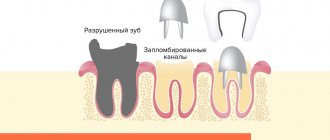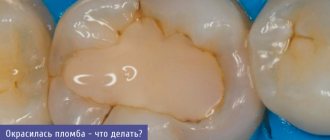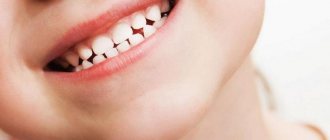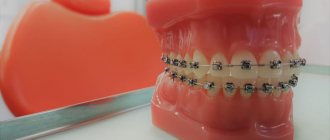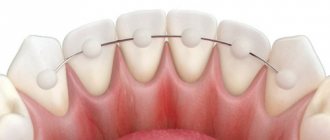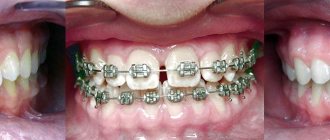Sometimes, after installing braces, a person notices that his teeth have become too mobile. Many people begin to panic and go to the dentist to remove the orthodontic appliance. But in most cases, tooth mobility is normal. In this article we will tell you why teeth become loose after braces and what needs to be done.
In this article
- Changes in the mouth while wearing braces
- Why are teeth loose?
- Why do teeth wobble under braces from an anatomical point of view?
- What to do if teeth become loose under braces?
- Why do you need retainers for loose teeth?
- In what cases is loose teeth not normal?
- Proper care will protect against loose teeth
Changes in the mouth while wearing braces
Installing a brace system to correct a bite or straighten teeth is almost always accompanied by an adaptation period. In some patients it can be several days, in others - a couple of weeks, it depends on the individual characteristics of the body. During the adaptation period, elements of the orthodontic structure can rub the mucous membrane, lead to the formation of ulcers on the inside of the lips and cheeks, and cause discomfort. Patients are warned about possible temporary disturbances in diction and difficulties in pronouncing certain sounds.
But practice shows that many are not prepared for the loosening of their teeth while wearing braces. If a tooth is loose under braces, there is a fear of losing it. Is it really possible to lose loose teeth on which braces are attached? In most cases, unusual mobility is normal and, as long as your dentist recommends it, will not lead to tooth loss.
Mobility of the bracket system
If you do not maintain proper hygiene while wearing braces, the structure may begin to wobble. This can be caused by deformation of the archwire, unsticking or displacement of the bracket. The cause may also be a loose ring that secures the structure.
If there is any damage to the alignment structure, it is important to contact an orthodontist. If a visit to the clinic for some reason cannot be carried out in the near future, the element that has lost its fastening strength should be secured with orthodontic wax. But you shouldn’t put off visiting the doctor too much. In the absence of structural elements or their poor-quality fastening, load redistribution occurs, which can cause serious adverse consequences.
Why are teeth loose?
To understand the reason why a tooth is loose, you need to know how the braces system works and how it works. The design of the bracket system is such that a small lock is attached to each tooth according to a certain pattern. An orthodontic arch made of shape memory material is installed in the fastenings of each lock. This arch puts pressure on the dentition and promotes tooth movement.
What causes the displacement? Under the influence of a directed load, the bone tissue on one side decreases, the tooth socket expands, which allows the tooth to move to a new location. At the same time, in order for him to sit firmly in a new place, on the other hand, the bone tissue must grow, this process takes time. During the period when the socket has already widened, and not enough new bone tissue has grown, the teeth can be mobile. That is, their mobility during the period of movement is the norm, which should not frighten. The main thing is to fix the tooth in its new place in the jawbone after displacement.
Problems after committing
The structure of the dentition is characterized by the connection of teeth and bone tissue with the help of ligaments surrounded by a dense structure that maintain a stable position. The pressure exerted by braces reduces the density of fixation. At the same time, natural factors that arise after the installation of an orthodontic apparatus include:
- Slightly expressed mobility of units;
- The problem appears in the first days after fixation.
Preservation of the natural state of the gum tissue (without inflammatory processes and acute pain) indicates the normal development of events. If there are uncharacteristic symptoms, as well as doubts about the physiological correspondence of the changes that occur, it is recommended to undergo a comprehensive examination to identify anomalies and pathologies.
Why do teeth wobble under braces from an anatomical point of view?
Teeth are made up of two main parts—the dental crown (the visible part) and the root. They are connected to each other by a ligament supported by bone tissue. Under the pressure of braces, the tooth tilts, as a result of which the distance between the ligament and the dental crown changes: on the one hand it becomes larger, and on the other, on the contrary, smaller. Special cells - osteoblasts - begin to actively work and restore the missing bone tissue to create a new support for the tooth. Other cells—osteoclasts—perform the opposite job: they promote the resorption of bone tissue where the tooth needs to be moved.
In this way, the pinched connective ligament gradually straightens out, and the tooth can take its correct position. Such cycles of loss and growth of bone tissue are repeated many times during orthodontic correction, contributing to the gradual correction of the dentition.
But the speed of these processes is different: bone tissue is absorbed faster than it grows. This is the main reason why teeth become loose after braces start working.
Looseness during treatment
Some patients experience that their teeth begin to wobble a little under braces. This is a completely adequate reaction of the body to the pressure exerted. If no accompanying symptoms appear, such as bleeding, gum pocket formation or severe pain, then there is no need to worry. But in any case, it is best to consult with an orthodontist; only he can rule out complications and help prevent tooth loss in the future.
Orthodontic structures are used to correct bite defects; they are effective at any age and allow you to cope with pathologies of any complexity. The teeth begin to move due to the pressure that the metal arch puts on them. The arch, in turn, is fixed in the locks of the braces installed on each tooth. With strong defects, loosening of individual units may be observed; this is a normal phenomenon during their displacement.
However, in addition to the physiological reaction, loosening can also be provoked by pathological processes. The cause can only be determined based on a thorough diagnosis in the clinic, so you should not delay the examination.
What to do if teeth become loose under braces?
First of all, you need to contact an orthodontist and make sure that the loosening process is physiological and does not threaten the teeth. If the doctor confirms that everything is in order, then you just need to follow the dentist’s recommendations. In particular, reduce the load on the teeth:
- temporarily avoid solid foods (carrots, apples, nuts, caramels, seeds);
- exclude chewing gum, toffees, corn flakes, dried fruits and other foods that stick to the teeth;
- do not bite nails or pencils;
- follow a “soft” diet, which includes mainly liquid and puree dishes (porridge, pates, smoothies, vegetable and fruit purees).
Following these recommendations will not only prevent the loss of mobile teeth, but will also protect the braces from damage. For accelerated bone tissue regeneration, it is important that the diet contains protein products and a full range of essential minerals and vitamins.
Folk remedies to prevent loosening
The right thing to do if you notice problems with your braces is to visit an orthodontist. But, if there is a lot of time left before the visit, you can help yourself with some folk remedies. Various herbs and home remedies are used for this, but toothpaste is the best one.
You should squeeze the paste onto your toothbrush as if you were brushing your teeth normally and drop some essential oil on it (one drop will be enough). It is a natural antiseptic that is often used to protect gums from inflammation. You should brush your teeth with this solution at least twice a day.
Let's look at other folk tricks:
- Licorice root reduces plaque formation on teeth;
- Massaging the gums using turmeric, black pepper and alum helps a lot;
- Blueberry roots and hawthorn berries significantly strengthen teeth.
Why do you need retainers for loose teeth?
After removing the braces, in most cases it is necessary to wear a special orthodontic mouthguard, or retainer. Its main function is to fix and hold the teeth in the correct position until the process of regeneration of new bone tissue is completely completed. If you neglect to wear a retainer, your teeth may return to their original place after the braces are removed.
The retention period when it is necessary to wear a mouth guard lasts approximately 2 times longer than the period of wearing braces. On average it is 3-4 years. During this time, the process of bone tissue restoration should be completely completed, the teeth will completely stop loosening and will remain securely in their new place.
Reviews
Orthodontic treatment is a long and serious process, on which not only the beauty of the dentition, but also its health depends.
Therefore, problems may arise, and it is best to pay due attention to their solution by immediately contacting a doctor. However, in most cases, mobility and unsteadiness are normal.
In the comments to this article, you can share your experience or leave feedback.
If you find an error, please select a piece of text and press Ctrl+Enter.
Tags: braces vestibular braces
Did you like the article? stay tuned
No comments yet
In what cases is loose teeth not normal?
Rarely, there are situations when the cause of tooth loosening is not in the physiological process of resorption and growth of bone tissue, but in some kind of disease.
For example, teeth may become loose if a patient develops osteomyelitis or osteoporosis. Also a common cause of pathological loosening is periodontal disease in the acute stage. Teeth become mobile due to gingivitis, periodontal disease, and periodontitis.
And if bone pathologies arise on their own, then periodontal diseases are most often caused by insufficient hygienic oral care and braces.
In any case, to exclude pathology of the bones or gums, at the first sign of loose teeth, you should consult a dentist. The doctor will conduct a full diagnosis, determine why the teeth are loose and, depending on the results of the examination, prescribe treatment or give recommendations.
What to pay attention to
Another outcome is possible: due to interference in the jaw system, inflammation in the tissues may develop. It is accompanied by the following symptoms:
- swelling of the gums;
- rapid development of caries;
- the appearance of plaque or ulcers inside the oral cavity;
- weakening of enamel;
- severe pain when lightly touching the jaw;
- flowing pus or blood.
Together, these signs are symptoms of a number of serious diseases - for example, gingivitis, periodontal disease or bruxism. Under such circumstances, it is impossible to delay treatment - this will quickly develop into a serious problem with unpleasant consequences: tooth loss and the spread of purulent infection.
Doctors say that after the teeth are displaced and their unstable position, it is easy to develop a complication. If you do not follow the rules of personal hygiene regarding the oral cavity, or neglect the rules of wearing braces, the disease will progress.
Proper care will protect against loose teeth
One of the causes of loose teeth is periodontal tissue disease. To prevent their development, you need to properly care for your mouth while wearing an orthodontic appliance.
Proper care involves daily brushing of teeth with 3-4 types of brushes - regular, special orthodontic with a V-shaped bristle, single-tuft and brush-brush. These devices are used alternately, gradually removing all dirt and plaque. After brushing your teeth, you need to clean the interdental spaces using superfloss - a special orthodontic dental floss. At the final stage, the oral cavity and the braces system are cleaned using an irrigator. This device directs a powerful stream of water, which removes dirt from interdental spaces, periodontal pockets and other difficult areas. To care for braces, it is important to purchase irrigators with special orthodontic attachments.
Careful and regular oral care will prevent pathological loosening of teeth under braces and avoid their loss.
Alarm bells
It is not always normal for teeth to become loose when correcting a bite. There are situations when a patient, in parallel with treatment, develops an inflammatory process in the hard or soft tissues of the oral cavity.
In order not to miss the onset of the disease, dentists recommend paying attention to the appearance of the following signs:
- redness, swelling and bleeding of the gums;
- carious lesions on the surface of molars;
- formation of erosions and ulcers on the mucous membrane;
- pathological abrasion of enamel;
- severe pain in certain areas of the jaw arch;
- the appearance of purulent discharge.
The listed signs may indicate the development of serious diseases of the teeth and gums in a person - gingivitis, periodontal disease, osteomyelitis, bruxism, osteoporosis.
These conditions require urgent treatment, since, gradually progressing, they can lead to the destruction or loss of teeth, the development of purulent-necrotic processes and fractures of the jaw bones.
Dentists note that the development of pathological conditions that cause loosening of teeth can occur for various reasons. Most often this happens due to poor oral hygiene, non-compliance with the rules of wearing braces, or injury to the jaw.
Tooth loss during and after braces
If your teeth are loose, braces are not recommended. You must first determine the causes of this symptom and get rid of them. Braces can only be placed on a healthy jaw.
Sometimes it happens that teeth fall out after braces. This problem is faced by patients who had jaw pathologies before the installation of corrective plates. In this case, the dentist chooses the further treatment method. It is necessary to first establish and eliminate the cause of the loss, restore the evenness of the row and perform prosthetics.
Distal bite: what is it and how does it happen?
This is an anomaly in which the lower jaw “retracts” to the rear position, and the upper jaw protrudes forward.
The defect may be mild and almost invisible. Or it turns out to be too obvious.
Braces correct distal occlusion, but you need to seek help from a professional who has many successfully treated clinical cases.
This violation is divided into types:
- Horizontal. The incisors of the upper jaw are inclined, raised towards the lip. The lower antagonists rest against the sky.
- Vertical. The upper incisors are inclined inward, often touching the gums near the lower ones.
The chin visually appears small. Doctors name several signs
, which indicate the severity of the pathology:
- There is a minor problem when the sixth upper and lower teeth are in contact.
- If closure is not observed, the unit ends up between the fifth and sixth antagonists, then urgent intervention is necessary and a long treatment process will be required.
The distal bite can be corrected and after wearing braces the profile becomes symmetrical and proportional.
Principle of operation
Immediately after braces are installed, they begin to put pressure on the teeth, gradually causing them to move. During this, the ligaments that are located around the unit are strained. As a result, the human body tries to compensate for the lack of tissue in the place where the fibers have been greatly stretched, and vice versa.
Where the fibers are strongly compressed, the tissues begin to gradually dissolve, freeing up space for the movement of adjacent teeth. The main advantage of using braces is that the results obtained, if all the specialist’s recommendations are followed, remain with the person for life.
The teeth begin to shift not because the brackets are attached to them, but due to the pressure of the metal power arc that connects them together. To maximize the effect of treatment, the arch should be changed periodically. This is due to the fact that over time the force of its pressure weakens. Also, at one of the regular preventive examinations, a specialist may come to the conclusion that it is necessary to install a more rigid arch.
